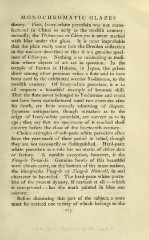Page 341 - Oriental Series Japan and China, Brinkly
P. 341
MONOCHROMATIC GLAZES
theory. First, Ivory-white porcelain was not manu-
factured in China so early as the twelfth century ;
secondly, the Te-hwo-yao or Chien-yao is never marked
with blue under the glaze. It is most improbable
that the plate really came into the Dresden collection
in the manner described or that it is a genuine speci-
men of Chien-yao. Nothing is so misleading as tradi-
tion where objects of art are in question. In the
temple of Benten at Hakone, in Japan, the priests
show among other precious relics a flute said to have
been used by the celebrated warrior Yoshitsune, in the
twelfth century. Of Ivory-white porcelain, it is in
all respects a beautiful example of keramic skill.
That the flute never belonged to Yoshitsune and could
not have been manufactured until two centuries after
his death, are facts scarcely admitting of dispute.
Japanese antiquarians, though mistaken as to the
orign of Ivory-white porcelain, are correct as to it?
age ; they say that no specimens of it reached their
country before the close of the fourteenth century.
Choice examples of soft-paste white porcelain often
have the year-mark of their period in relief, though
they are not necessarily so distinguished. Hard-paste
white porcelain as a rule has no marks of either date
Aor factory.
notable exception, however, is the
Yung-lo To-tai-ki. Genuine bowls of this beautiful
ware always carry, on the bottom of the inner surface,
the ideographs Yung-lo or Yung-lo Nien-chi, in seal
character in bas-relief. The hard-paste white porce-
lain of the present dynasty, if marked at all which
is exceptional has the mark painted in blue sous
couverte.
Before dismissing this part of the subject, a ware
must be noticed one variety of which belongs to the
275

